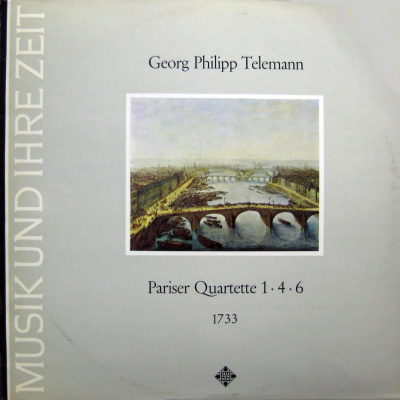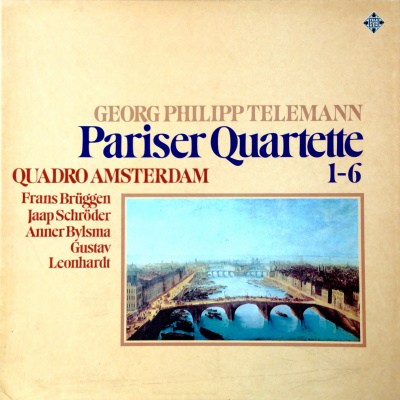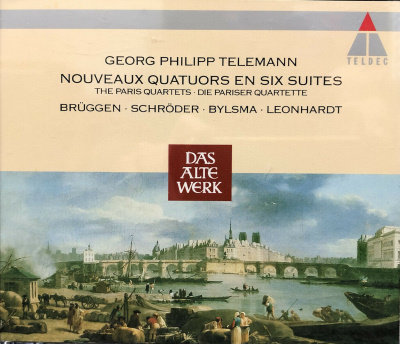 |
|
1 LP -
SAWT 9448-A - (p) 1964
|
 |
| 2 LPs -
6.35065 DX (TK 11565/1-2) - (p) 1974 |
 |
| 2 CDs -
4509-92177-2 - (c) 1993 |
|
PARISER
QUARTETTE 1 · 4 · 6
"Nouveaux Quatuors en Six suites à
une flûte traversière, un violon, une
basse de viole ou violoncelle et basse
continue", Paris 1733
|
|
|
|
|
|
|
|
| Georg Philipp
TELEMANN (1681-1767) |
Quartett
Nr. 1 D-dur |
|
15' 45" |
|
|
-
Prélude (Vivement)
|
2' 05" |
|
A1
|
|
- Tendrement
|
1' 48" |
|
A2
|
|
-
Vite
|
2' 13" |
|
A3 |
|
-
Gayment
|
4' 28" |
|
A4
|
|
-
Modérément |
3' 04" |
|
A5 |
|
-
Vite
|
2' 07" |
|
A6 |
|
Quartett
Nr. 4 h-moll |
|
18' 30" |
|
|
-
Prélude (Vivement)
|
3' 37" |
|
A7 |
|
-
Flatteusement |
2' 11" |
|
A8 |
|
-
Coulant |
2' 29" |
|
A9 |
|
- Gay |
1' 48" |
|
A10 |
|
-
Vite |
1' 29" |
|
B1 |
|
-
Triste |
3' 06" |
|
B2 |
|
-
Menuet (Modéré)
|
3' 55" |
|
B3 |
|
Quartett
Nr. 6 e-moll |
|
17' 08" |
|
|
-
Prélude (à discretion-très vite-à
dsicretion)
|
2' 48" |
|
B4 |
|
- Gay |
2' 48" |
|
B5 |
|
-
Vite |
1' 19" |
|
B6 |
|
-
Gracieusement |
2' 12" |
|
B7 |
|
-
Distrait |
2' 52" |
|
B8 |
|
-
Modéré |
5' 09" |
|
B9 |
|
|
|
|
|
QUADRO AMSTERDAM
- Frans Brüggen, Querflöte
(Richard Hammig, Marktneukirchen 1958)
- Jaap Schröder, Violine (Giovanni
Grancino, Mailand 1701)
- Anner Bzlsma, Violoncello (Carlo F.
Landolfi, Mailand 1753)
- Gustav Leonhardt, Cembalo (J. C.
Neupert, Bamberg 1932)
|
|
|
|
|
|
Luogo
e data di registrazione |
|
Hervormde Kerk,
Bennebroek (The Netherland) - 6/8
Ottobre 1963
|
|
|
Registrazione:
live / studio |
|
studio |
|
|
Producer |
|
Wolf Erichson
|
|
|
Engineer |
|
Dieter Thomsen
|
|
|
Prima Edizione
LP |
|
Telefunken "Das Alte
Werk" | SAWT 9448-A | 1 LP -
durata 51' 33" | (p) 1964 | ANA
Telefunken
| 6.35065 DX (TK 11565/1-2 | 2
LPs - durata 51' 33" - 52' 27" |
(p) 1974 | ANA | Riedizione
|
|
|
Edizione CD |
|
Warner Classics |
LC 6019 | 4509-92177-2 | 2 CDs -
durata 71' 36" - 73' 01" | (c)
1993 | ADD |
|
|
Cover
|
|
Grevenbroek: "Ansicht
von Paris".
|
|
|
Note |
|
-
|
|
|
|
|
“A
Quatuor, or a Sonata with
three concerting instruments
and a bass part, is actually
the criterion of a genuine
contrapuntist; but also an
opportunity at which many a
composer, who is not
properly grounded in his
science, can badly fall. The
use of it has never been
very general; consequently
it cannot be so very well
known to everybody either.
... Six particular Quatuors
for various instruments,
mostly flute, hautboy, and
violin, which Herr Telemann
composed already quite a
time ago, but which have not
been engraved in copper,
can, in this kind of music,
provide excellently
beautiful models.“
When Johann Joachim Quantz
published this verdict in
his Flute Method in 1752,
Telemann, so highly praised
as exemplary, was still at
the height of his European
fame and of his creative
power. There was hardly any
type of musical composition
of that period that he did
not master with a
superabundance of works,
hardly any whose traditional
character he did not
considerably transform as
the result of searching and
experimenting in the course
of a long creative life
spent between the baroque
and classical eras. The
“Quadro“ or “Quatuor“, about
whose history very little is
known as yet, lent itself
admirably as a young
category to such
experimenting; in the many
ramifications of its
development it became one of
the most important
precursors of the classical
String Quartet. Almost at
the very beginning of this
development - in Germany at
least - stand Telemann’s
“Quatuors en Suites“ which,
like most of this master’s
quartets, were printed in
Paris - concrete evidence
that these works in
particular were felt to be
novel and unique in France.
(When Telemann made his
triumphal journey to Paris
in 1737-38, in addition to
works of church music it was
his quartets above all else
that were performed in
public and private
concerts).
The “Quatuors en Suites“
clearly show the
intermediate position of
this category between the
late baroque and early
classical styles. The formal
scheme of the works, “en
Suites“, unusual for that
time and almost certainly
aimed at the French public,
displays manifold
modifications when compared
with the suite tradition.
The tonal unity of the
latter is now varied; the
traditional Overture is
frequently replaced by a
‘concertante‘ movement;
dance movements appear with
designations of expression
instead of with their old
form designations and tend
towards the “characteristic
piece“ full of sensibility,
only retaining the form of
the baroque dance piece;
traditional polyphony,
song-like sections that
enjoy moving in thirds over
modern, broken-chord basses
and a ‘concertante' varying
of the writing with changes
of tone colours and thematic
contrasts constantly
alternate with one another.
This colourful, even
paradoxical assortment of
phenomena are welded into an
artistic unity by those
musical qualities that raise
Telemann’s best works far
above the level of merely
skillful, mechanical
facility in writing: clarity
and simplicity of form, an
inexhaustible abundance of
concentrated, pictorial and
highly expressive ideas and
a peculiar blend of
refinement and directness
that imparts to Telemann’s
chamber music in particular
a highly attractive quality.
The Quartet in D Major
begins with a gay Allegro
that lies somewhere between
an Allemande and a concerto
movement, which is followed
by an elegiac Sarabande. The
third movement returns in
its mood and formal scheme
to that of the Prélude; it
is then followed by a
delicate, ‘galant‘ Minuet, a
characteristic piece that
again has an elegiac
character and finally a
carefree Gigue whose triad
motifs suggest a gay hunting
atmosphere with which the
work is brought to a
turbulent close.
The B Minor Quartet is both
in its conception and its
lay-out on a larger scale.
Again there is a quick
‘concertante‘ Prélude
instead of the traditional
Overture, which is repeated
after the insertion of a
‘galant‘ 3/8 Minuet
(Flatteusement). The next
movement (Coulant) is
already quite pre-classical,
both in its thematic
material and in its mood,
and is only remotely
reminiscent of baroque dance
types. This is followed by a
bucolic, popular-styled
Gigue, a witty ‘concertante‘
Gavotte and a dignified
Sarabande. The work closes
with a Minuet which, in its
‘concertante‘ variational
shaping and its extensive
dimensions, is far more a
pre-classical, symphonic
“Tempo di Minuetto“ (and
thus a genuine, weighty
closing movement, not a
light final dance) rather
than a courtly baroque
Minuet. The E Minor Quartet,
probably the most important
of the three works, begins
with a traditional French
Overture whose formal
details are, however,
considerably and
characteristically modified
compared with the
conventional model (in the
slow section through a
stylized violin cadenza, in
the Allegro by means of
free, non-fugato
part-writing). It is
followed by an energetic
Gavotte with a gloriously
melodious middle section, a
Courante-like movement and
two contrasting
“characteristic pieces“, the
first in E Major, varying
the tonal unity of the
suite, the second linked
with one of Telemann’s
specialities - the Polonaise
style. The Finale is still
more clearly contrasted with
the traditional model than
in the B Minor Quartet; it
is a Chaconne, broadly laid
out and varied in
‘concertante‘ style, in
melancholy Sarabande
character and leading up to
a magnificent climax, and
thus breaks not only with
the suite tradition, but in
its wealth of contrasted
expression also with the
traditional unity of emotion
of a baroque suite movement.
In spite of its Chaconne
form, the way to the
classical finale from this
amazing movement is no
longer far.
Ludwig
Finscher
|
  |
|
|